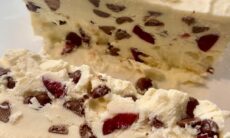3 Ingredient Yogurt: A Deliciously Simple & Healthy Treat
Craving a guilt-free treat that’s incredibly easy to make? Look no further than 3 Ingredient Yogurt! This isn’t your average yogurt; it’s a creamy, decadent, and surprisingly versatile dessert or snack that requires only three simple ingredients. Forget complicated recipes and lengthy preparation times – this recipe is all about simplicity and flavor.
What makes this yogurt so special? It’s the perfect blend of tangy yogurt, sweet condensed milk, and a touch of your favorite flavor extract. The combination creates a rich, almost mousse-like texture that will tantalize your taste buds. Plus, it’s packed with protein and probiotics from the yogurt, making it a healthier alternative to processed desserts.
The best part? The customization options are endless! Want a vanilla dream? A few drops of vanilla extract will do the trick. Craving a fruity burst? Stir in some mashed berries or a spoonful of your favorite jam. Chocolate lover? A dash of cocoa powder will transform it into a chocolatey delight.
3 Ingredient Yogurt is perfect for a quick breakfast, a post-workout snack, or a light dessert. It’s also a great option for kids, as it’s a fun and healthy way to get them to eat more yogurt. Whether you’re a seasoned cook or a beginner in the kitchen, this recipe is guaranteed to become a staple in your repertoire.
So, ditch the processed snacks and embrace the simplicity and deliciousness of 3 Ingredient Yogurt. It’s a healthier, tastier, and more satisfying way to indulge your sweet tooth. Get ready to experience yogurt in a whole new light! Experiment with different flavor combinations and discover your own signature 3 Ingredient Yogurt creation. You won’t be disappointed!













